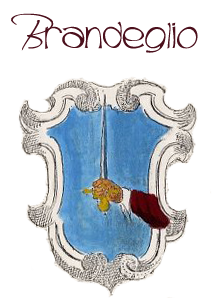-
Brandeglio
Posted on Agosto 21, 2012 by AntonellaG. in TerritoryBrandeglio is 640 meters above sea level to reach Brandeglio take the crossroad on the statale del brennero at Pian dell’ospedaletto 9 kilometers from Bagni di Lucca. One can see the beauty and feel the charm of Brandeglio only when one aarives.The view of Crasciana and Casabasciana are wonder ful.In the square there’s a chapel dedicated to the Madonna delle Grazie the fountain of the village has a inscription by F.Cianelli,the first world war monument.The bell tower gathers around it all the village.It’s name comes from the noble roman Blandius even thoughsomeone says it comes fron the Lombard Brand spade the spade is in the coat of arms of the village.
The History
Brandeglio is remembered in a few parchments from Lucca dated in the years 918,950 and 985 like the village of the population of San Quirico e Giulietta of Casabasciana. It was a stronghold of the Lupari family until they where baned from the territory by the town of Lucca.It became part of the parish of Val di Lima, it became unruly that in the 15th century the vicar confined some inhabitants to Maremma. In the municipal records ther are files of the comunity, though many where lost, theres only one statute of rights from the files of the state of Lucca dated 1772 The parish church is dedicated to Santa Maria Assunta it has three aisles and an antique baptism fountain. The organ dates from the 17th century.In 1902 the company Poali rearranged the organ but left untouched the sound system.Below the village theres ruins of the church dedicated to San Michele o il Spirito Santo, this was probably the old parish church of Brandeglio.It was inhabitated until the 16th century by a hermit, but even in that period needed ristructuring.There used to be a procession the day after pentacost butbtoday it just ruins.Famous People
Father Raffaello Iacomini (1785-1844),missonary
Monsignor Filippo Franceshini(1924-1988)-bishop of Padova and member of the CEI. -
Brandeglio
Posted on Maggio 16, 2012 by AntonellaG. in Frazioni e LocalitàÈ a 640 metri sul livello del mare, per raggiungerlo bisogna prendere il bivio dalla Strada Statale del Brennero all’altezza di Pian dell’Ospedaletto, dista dal capoluogo nove chilometri. Si percepisce il fascino di Brandeglio soltanto una volta arrivati in paese e bellissimo è il panorama con Crasciana e Casabasaciana che lo guardano di fronte. Nella piazza, la più ampia dei paesi montani del Comune di Bagni di Lucca, troviamo la cappella della Madonna delle Grazie, conosciuta dai paesani col nome di “La Chiesina”, la fontana del paese con una iscrizione del latinista F. Cianelli, il monumento i caduti della Grande guerra. Il campanile, a merli ghibellini, raduna intorno a sé l’intero paese. Il nome deriva dal gentilizio romano Blandius anche se qualcuno lo vuole far derivare dal longobardo Brand, spada, di qui la spada che compare nello stemma del paese.
La storia di Brandeglio
Brandeglio è ricordato in alcune pergamene lucchesi degli anni 918, 950 e 985 come villa del plebato di San Quirico e Gulitta di Casabasciana. Fu feudo dei Lupari fino al bando della potente famiglia dal territorio del Comune di Lucca. Divenne parte della Vicaria di Val di Lima e tanto era turbolento che nel sec. XV il Vicario confinò alcuni dei suoi abitanti in Maremma. Nell’Archivio comunale sono conservati gli atti della Comunità, mentre sono dispersi gli antichi Statuti tranne uno del 1772 conservata nell’Archivio di Stato di Lucca. La chiesa parrocchiale è dedicata a Santa Maria Assunta ed è a tre navate con l’antico fonte battesimale. L’organo risale probabilmente al XVII secolo ed è stato rimaneggiato, lasciando però integro il materiale fonico, nel 1902 dalla Ditta Paoli. Sotto il paese, in località Montaglioni, troviamo i ruderi della chiesa di San Michele e dello Spirito Santo detta al Santo alla Villa probabilmente l’antica parrocchiale di Brandeglio. Abitata fin dal sec. XVI da un eremita, abbisognava già in quei tempi di restauro. Era in uso andarvi in processione il giorno dopo Pentecoste ma oggi è diroccata.Personaggi celebri
Padre Raffaello Iacomini (1785-1844), minore riformato, missionario.
Monsignor Filippo Franceschi (1924-1988) vescovo di Padova e membro della CEI Padre Filippo Maria Cioni








